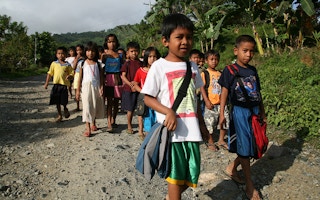In many developing countries, women come together on a regular basis to contribute their earnings to a common pot. Together, these micro-contributions can pay for school fees, kick-start a joint business venture, or buy the best available seeds for the next planting season. Pooling resources has a community-wide impact.
Of course, these individual contributions are small compared to the broader challenges of improving nutrition and creating employment, let alone achieving the 17 United Nations Sustainable Development Goals (SDGs).
Meeting the SDGs will cost trillions of dollars, and financial pledges to date fall well short of what is required. Community solidarity must therefore become an integral part of a global citizen movement to contribute to human progress.
Fortunately, the rapid growth of digital platforms and payment systems makes it possible to replicate the community-level pooling mechanism on a global scale to help those most in need.
Although community pooling of funds is not new, large payment platforms such as WeChat, GoFundMe, and M-Changa have digitised solidarity, making it easier than ever for communities around the world to cooperate in addressing problems and responding to crises.
This sense of community was evident this year in the aftermath of large-scale disasters, including Cyclone Idai in southern Africa and the fire at the Notre Dame cathedral in Paris, as it was following the 2004 Indian Ocean earthquake and tsunami.
Yet technological advances in the intervening decade and a half meant that the responses were very different. After the tsunami, individuals could not respond directly to help the affected communities in Southeast Asia and Africa. Today, mobile banking can translate compassion into dollars.
But what about less visible tragedies, such as stunting in children? It is harder to galvanise people around issues that do not make global headlines. Yet stunting, or chronic malnutrition, is a huge problem that cries out for community collaboration to address it.
Stunting is the result of limited or no access to adequate nutrition during pregnancy and the first two years of a child’s life. Globally, the condition affects about 22 per cent of children under the age of five; most live in Africa and Asia.
By slowing children’s physical and cognitive development, stunting limits their opportunities in life and makes them less able as adults to contribute to their country’s social and economic transformation. The resulting skill shortage poses significant risks to future economic growth in Africa, Southeast Asia, and India, and hence globally.
“
Globally, stunting affects about 22 per cent of children under the age of five; most live in Africa and Asia.
Although the initial cost of stunting is borne by the child’s family, the economic impact affects us all.
Whereas natural disasters tend to be one-off events that demand a massive immediate response, providing mothers and children with the nutrients and vitamins they need requires a consistent, sustained effort over time.
That is the thinking behind UNITLIFE, a new UN initiative that aims to tackle stunting with the support of people around the world. By mobilising individual voluntary micro-donations, UNITLIFE will help to fund nutrition programs in developing countries, particularly in Sub-Saharan Africa.
The initiative, which is hosted by the UN Capital Development Fund, is based on the successful innovative finance organisation UNITAID, whose $3 billion fund to fight diseases is financed by an air-ticket solidarity levy implemented in ten countries.
Over the past 15 years, telecoms operators, banks, and fintech firms have developed mobile and e-payment systems that allow people to transfer money at the speed of a tweet.
From the comfort of her home, a resident of Los Angeles or Nairobi can donate to support an anti-stunting program in eSwatini (Swaziland). And shoppers can contribute affordable amounts at the checkout, turning the simple act of swiping or scanning their cards into a global phenomenon for development impact.
Anyone, in fact, can contribute to UNITLIFE by scanning a QR code and adding an affordable contribution to their online or in-store purchases. And with 20 billion credit, debit, and prepaid cards in circulation around the world, there are almost limitless ways to support the fight against stunting.
People are the world’s most important resource, yet stunting limits human capabilities and reduces current investment in the future. Fortunately, the rapid growth of digital technologies means we can now imagine a world in which millions of small voluntary donations help to end this scourge, improving the lives of women and children immeasurably.
By pooling resources locally, women across Africa and Asia are raising their communities’ living standards. With a global community pot, we can strengthen the foundations of life, contribute to human progress, and secure our collective future.
Philippe Douste-Blazy, a former French foreign minister, is Special Adviser to the United Nations Secretary-General on Innovative Financing for Development. Carl Manlan, a 2016 New Voices Fellow at the Aspen Institute, is Chief Operating Officer at the Ecobank Foundation.
Copyright: Project Syndicate, 2019.
www.project-syndicate.org












